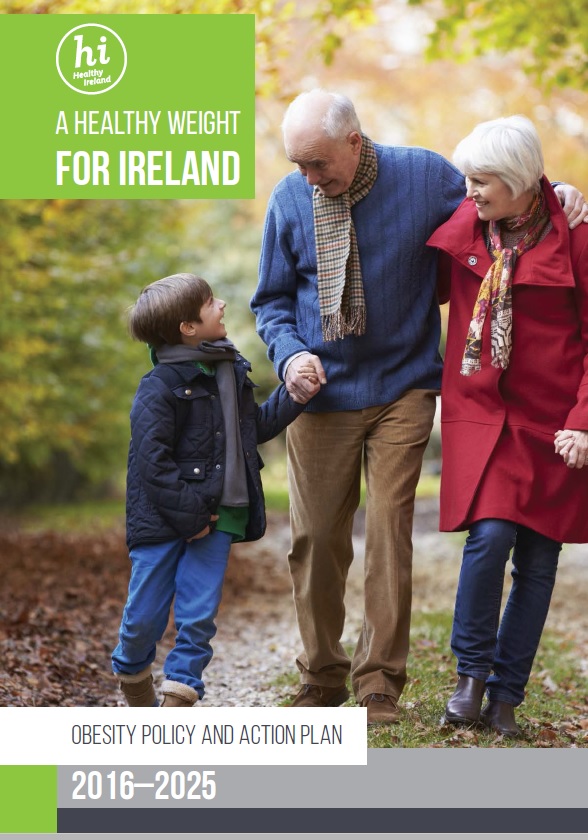Policy Context
In this section you will find details of the government policies and strategies that guide the work of the programme.
Two key national policies under Healthy Ireland are:
A Healthy Weight for Ireland – Obesity Policy and Action plan 2016-2025
Overweight and obesity are conditions that develop over a number of years in both children and adults. In the past two decades, levels of overweight and obesity in Ireland have doubled (Morgan et al, 2008). Only 40% of people in Ireland are now a healthy weight. Levels of o verweight and obesity are significantly higher in lower socio-economic groups.
verweight and obesity are significantly higher in lower socio-economic groups.
Overweight and obesity are significant risk factors for many chronic, non-communicable diseases such as heart disease, cancers, type 2 diabetes, mental ill-health, respiratory problems and musculoskeletal conditions (WHO/FAO Joint Expert Consultation, 2003; National Obesity Observatory, 2011). The burden of adult obesity in financial terms in Ireland has been estimated as €1.13 billion per annum (Safefood, 2012)
A Healthy Weight for Ireland – Obesity Policy and Action Plan sets out a cross-sectoral approach underpinned by national and international evidence to help people achieve better health and, in particular, to reduce the levels of overweight and obesity.
The key steps for the health service to implement are:
- Mobilise the health service to better prevent and address overweight and obesity through effective community-based health promotion programmes, training and skills development and through enhanced systems for detection and referrals of overweight and obese patients at primary care level
- Develop a service model for specialist care for children and adults.
Get Ireland Active - National Physical Activity Plan for Ireland
Being physically active is one of the most important steps that people of all ages can take to improve their health and wellbeing. There is significant evidence that physical activity of moderate intensity promotes wellbeing, physical and mental health, prevents disease, improves quality of life and has social and economic benefits. These benefits apply to all people irrespective of gender, ethnic background, ability, disability, size or age.
Conversely, physical inactivity is one of the leading risk factors for poor health and is now identified by the World Health Organisation as the fourth leading risk factor for global mortality.
Physical inactivity is not just a major health risk, there are also social and economic costs of inactivity. Inactive children are at higher risk of poorer self-esteem, higher anxiety and higher stress levels. They are more likely to smoke, use alcohol and illegal drugs than active children. Among working adults, inactive employees have double the number of days absenteeism from work compared with employees who are physically active. In later life, inactive people lose basic strength and flexibility for daily activities and many can lose independence and suffer from poorer mental health.

While detailed data on the burden of physical inactivity in terms of cost of health care provision in Ireland is not available, on the basis of international research, physical inactivity has been estimated to cost about €150-300 per citizen per year. In a worst case scenario this could imply a cost in Ireland of approximately €1.5 billion per year (WHO, 2006 Physical Activity and Health in Europe – evidence for action).
The National Physical Activity Plan sets out multi-sectoral approach to promote increased physical activity levels across the population providing a strong focus for modifying unhealthy lifestyle habits and promoting awareness of the benefits of physical activity in relation, not just to health, but in a wider socio-economic context.
The key action area for the health service to deliver on is:
Promote greater awareness and understanding of the health benefits of physical activity and deliver programmes to encourage increased participation.
In the health services, we have a really important role to play in Healthy Ireland, both working with other government departments, organisations and wider society, and also changing our own services for the people we care for. In July 2015 the HSE published Healthy Ireland in the Health Services National Implementation Plan 2015 - 2017, which is an implementation plan for the Healthy Ireland Framework specifically focussed on the HSE, our workforce, our services and the people we care for.
Healthy Ireland in the Health Services National Implementation Plan 2015 - 2017 has identified three clear strategic priorities for action because, in one way or another, every part of the health service is engaged in improving health and wellbeing. The plan outlines a sector-wide focus on
- System Reform - ensuring that we deliver the significant reforms which are underway to support a better health system
- Reducing Chronic Disease - the biggest risk to our population’s health and our services
- Staff Health and Wellbeing - ensuring we have a resilient and healthy workforce
